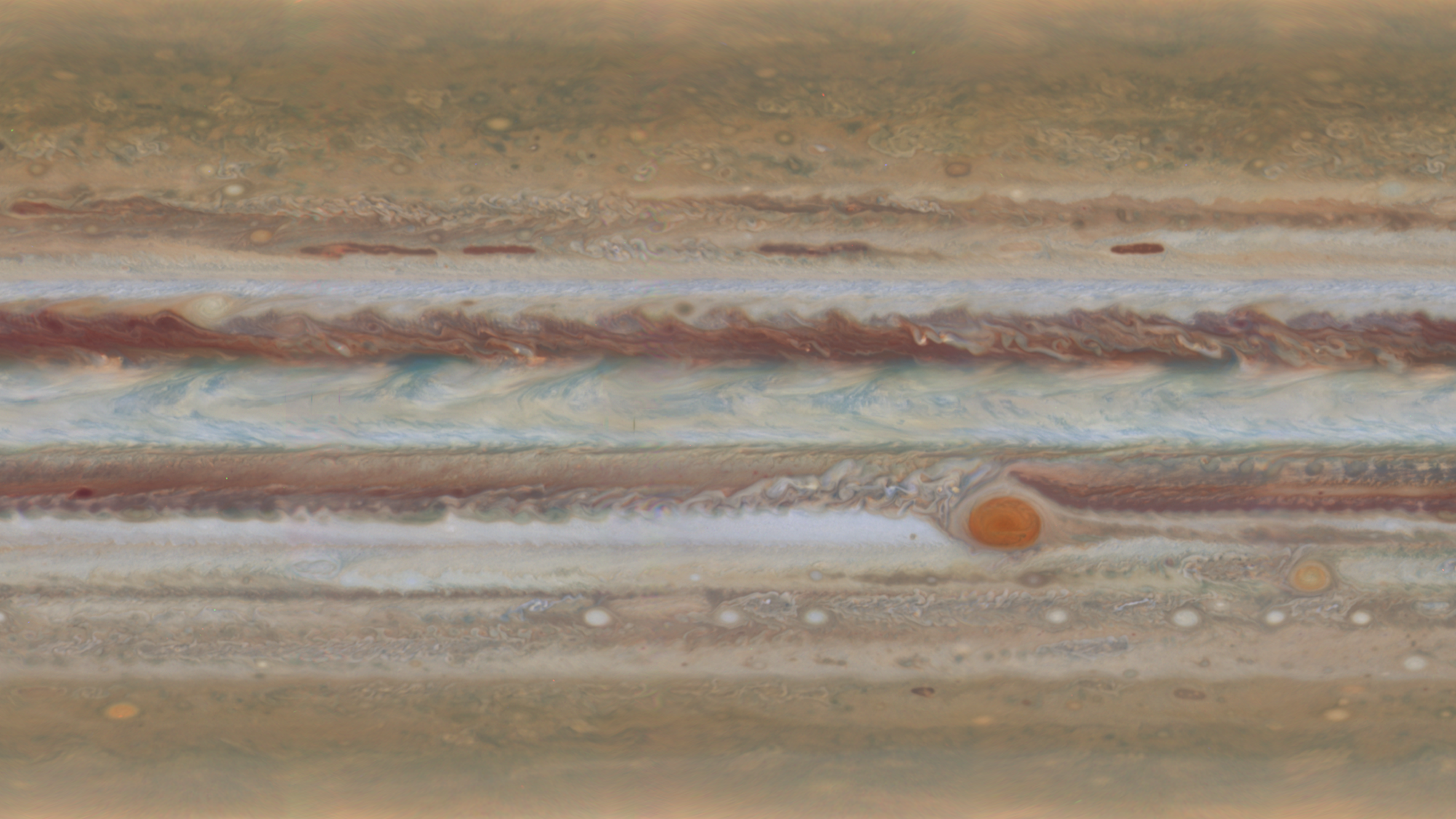
The first global map of the gas giant Jupiter, with its famed Great Red Spot towards the bottom left. It was created with images taken by the Hubble Space Telescope in 2015. NASA’s Goddard Space Flight Center/Space Telescope Science Institute
Jupiter’s Great Red Spot is shrinking. The biggest windstorm in the solar system has been slowly declining for decades, but some new research may explain why. There are fewer storms feeding this giant anticyclone, causing it to shrink. The findings are detailed in a study published in the September 2024 issue of the journal Icarus.
What is the Great Red Spot?
Arguably the gas giant’s most famous feature, the Great Red Spot is in Jupiter’s southern hemisphere. It is a swirling, red-orange oval of high pressure that’s over 10,000 miles wide. It is about 1.3 times wider than planet Earth.
The winds of the Great Red Spot consistently blow more than 200 miles per hour, but they can reach speeds over 400 mph further out. Since the Spot’s winds blow in a counterclockwise direction, it is technically an anticyclone.
[Related: Juno finally got close enough to Jupiter’s Great Red Spot to measure its depth.]
While it has been studied extensively, there are still many mysteries surrounding the Great Red Spot. Astronomers don’t know precisely when it formed, why it formed, or why it has this rosy color.
“Many people have looked at the Great Red Spot over the last 200 years and were as fascinated by it as I am,” study co-author and Yale University Ph.D. student Caleb Keaveney said in a statement. “A lot of those people were not professional astronomers—they were just passionate and curious. That, plus the curiosity I see in people when I talk about my work, makes me feel like part of something bigger than myself.”
What amateur and professional astronomers do know is that it has been shrinking for almost a century. It particularly has been getting smaller over the past 50 years. Its latitudinal extent–how far north or south the storm is positioned–has remained consistent. However, its longitudinal extent–how far east or west it is–has contracted over time. In the late 19th century, it was positioned at about 40 degrees. When NASA’s Juno spacecraft arrived to take a series of orbits around the planet in 2006, it found that the Great Red Spot was at 14 degrees.
Jovian storms and heat domes
In the new study, a team from Yale, North Carolina State University, and the University of Louisville, looked at the influence that smaller, transient Jovian storms have on the Great Red Spot. They conducted a series of 3D simulations of the Spot using a model called the Explicit Planetary Isentropic-Coordinate (EPIC) model. This atmospheric model was developed by study co-author Timothy Dowling during the 1990s and as a way to model another planet’s atmosphere.
Some of their models simulated interactions between the Great Red Spot and smaller Jovian storms of varying frequency and intensity. A separate group of control simulations left out the smaller storms. A comparison of the simulations suggests that presence of other storms strengthened the Great Red Spot, making it larger.
[Related: Why a 3,000-mile-long jet stream on Jupiter surprised NASA scientists.]
“We found through numerical simulations that by feeding the Great Red Spot a diet of smaller storms, as has been known to occur on Jupiter, we could modulate its size,” said Keaveney.
The team partially based their modeling on long-lived high-pressure systems that are observed in Earth’s atmosphere. These systems called heat domes or blocks occur regularly in the westerly jet streams that swirl across our planet’s mid-latitudes. They play a major role in extreme weather events, including heat waves and droughts.
The longevity of these blocks has been linked to interactions with smaller, more transient weather mechanisms–including high pressure eddies and anticyclones with their counter-clockwise winds.
“Our study has compelling implications for weather events on Earth,” said Keaveney. “Interactions with nearby weather systems have been shown to sustain and amplify heat domes, which motivated our hypothesis that similar interactions on Jupiter could sustain the Great Red Spot. In validating that hypothesis, we provide additional support to this understanding of heat domes on Earth.”
Additional modeling will help researchers to refine these new findings and could shed some new light on how the Great Red Spot formed in the first place.
>>> Read full article>>>
Copyright for syndicated content belongs to the linked Source : Popular Science – https://www.popsci.com/science/jupiter-great-red-spot-shrinking/































